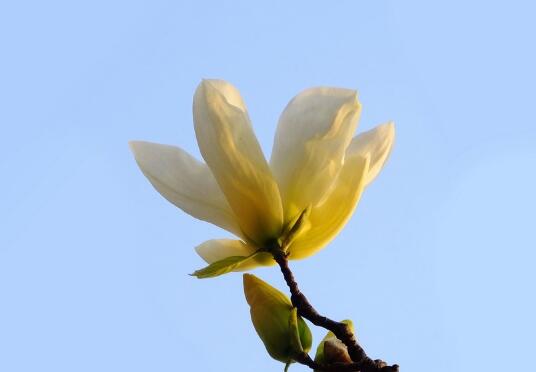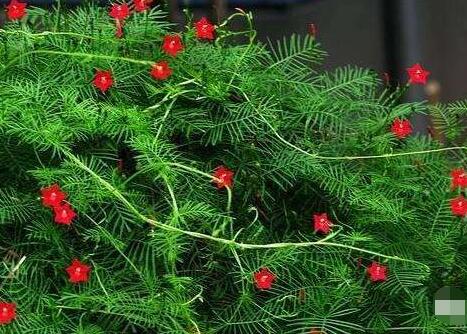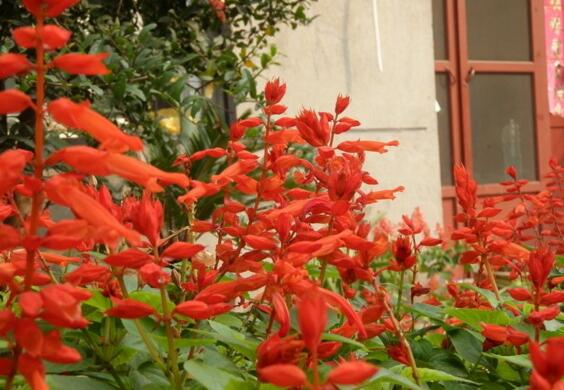How to plant magnolia in pot, culture methods and precautions / sufficient light of magnolia
Magnolia is a unique plant in China, which is highly ornamental. However, if you want to raise it well, you need to pay attention to a lot of things. About how magnolia is potted? What are the breeding methods and matters needing attention of magnolia? Next, the editor will take you to learn about it.
First, how to plant magnolia in pot and understand its habits

If we want to know how magnolia is potted, we must first understand its growth habits. Magnolia flowers like the sun, so we had better maintain sufficient light in the process of breeding it, in addition, watering, fertilization and other aspects can not be careless, the specific breeding methods are introduced in the following, let's take a look.
2. Culture methods and matters needing attention of Magnolia
1. Slightly acidic sandy soil
When we cultivate magnolia, we first need to choose soil, which is a step to lay a good foundation. Generally speaking, it is best to choose loose, fertile and slightly acidic sandy soil, which has good drainage and allows plants to absorb nutrients better. and it's not easy to cause stagnant water.
two。 Fertilize, fertilize twice during the growing period
Fertilizer is one of the main nutrients in the growth process of magnolia, although it likes fertilizer, but it avoids big fertilizer, so it is generally enough to apply fertilizer twice during the growth period, which is conducive to flower bud differentiation and growth. One of the two fertilizers is in early spring, and the other can be chosen around May to June.
3. Watering, dry and wet
In the growth process of magnolia, watering is also a point that needs to be paid attention to, it is more afraid of waterlogging, so we must control the amount of watering and keep the soil moist. We should keep the principle of seeing dry and wet when watering it, and wait until the basin soil is dry before watering.
4. Light, shade in summer
Magnolia is a kind of light-loving plant. Only by keeping enough light can it grow better. When the light is more suitable in spring and autumn, we can let it receive light all day. When the light is strong in summer, we need proper shading to avoid sunburn.
5. Prune an overgrown branch.
In the process of cultivating magnolia, we need to prune some overgrown branches, withered branches, disease and insect branches and branches that hinder the beautiful appearance of the tree in time, once to maintain the plant type, and wait until after its flowering period. We also need to cut off the residual flowers and ear of oysters, so as not to consume nutrients and affect their flowering in the coming year.
6. Diseases and insect pests should be treated with matrix.
In the growth process of magnolia, if we do not maintain properly, it is easy to appear bad phenomena such as diseases and insect pests, this kind of problem is very harmful to the plant, if it appears, we must deal with it in time. Specific treatment methods in the Magnolia flower pest control article, we have time to understand.
Cultivation methods and techniques of Magnolia potted plants and matters needing attention in its maintenance
When it comes to magnolia, I believe we are no stranger. Magnolia is a common ornamental flower, which is deeply loved by many flower friends. In addition to large varieties of trees, magnolia can also be potted. So, do you know the cultivation methods and matters needing attention of Magnolia potted plants? Today, the editor will give you a detailed introduction.
First, it requires fertile, loose and well-drained cultivated soil. It can be prepared with 5 parts of pine needle rotten leaf soil, 2 parts of crude bran ash, 2 parts of coarse sand and 1 part of retted barnyard manure, and do not use fine sand or clay with poor permeability. The upper basin uses ventilated tile pots (plain burning pots), do not use glazed pots, porcelain pots, purple sand pots, etc., it is best to use deeper cylindrical flowerpots, buckle empty flowerpots under the pots, and erect them with bricks to prevent poor drainage; the bottom of the basin is paved with about 5 cm of slag and gravel.
Second, the moisture should be suitable. White orchid is a fleshy root, the potted soil is too wet, the leaves will wither and fall off, and even the rotten roots will die, and if they are too dry, they will wither and curl their leaves. They are flowers that are afraid of both waterlogging and drought. During the flowering period, when the petals are too open, it shows that the water is insufficient, and the suitable moisture is in the shape of a bud; the surface of the basin soil is dry, and the soil should be watered immediately when the soil is hard and cracked. Watering requires that the water temperature and soil temperature must be the same, and can not suddenly pour cold or hot water. Watering must be thoroughly watered, often half of the water will cause shallow roots. White orchids should not be watered in spring and autumn, they should be watered every day in midsummer and must be watered in the evening, and the amount of water should be reduced at the end of autumn and watered every 10 days in winter. The overcast and rainy season should be moved to shelter.
Third, be afraid of alkali. White orchid prefers acid soil, and the requirement of soil pH value is 5.56.3. In the northern region, white orchids are not easy to raise because most of the water and soil there are alkaline, which dissolves the protoplasm of white orchid cells, resulting in slow growth and poor growth of flowers. Often irrigated with fermented Amoy rice water, the effect is better.
Fourth, be afraid of thick fat. White orchids like phosphorus and potassium fertilizer, but avoid too high concentration, otherwise it will produce reverse osmosis and cause "physiological drought" of the plant, wilting lightly or burning to death. The fertilization principle of white orchid is: "sparse application, regular application, evening application". Practice has proved that using thin human feces, urine and bean cake water mixed with smashed fish offal, rotten shrimp, chicken viscera, etc., after retting, it is applied every 3-5 days according to the proportion of fertilizer and water at 1:9, and calcium sulfate is added when it is applied, the effect is better, and the fragrance of white orchid can be strong.
Others: pick leaves and hearts. My Magnolia Magnolia leaves the shed from the Spring Equinox to Qingming Festival and chooses cloudy or cloudy days. 3 days after leaving the room, let the potted flowers adapt to the outdoor environment, and then remove the old leaves, leaving only a few tender leaves, so that they can promote the development of new shoots. After each batch of flowers, a small number of old leaves should be removed to promote the growth of new branches and the formation of flower buds. During the growth period, it is necessary to often pick the heart, control the apical dominance, and promote multiple lateral branches.
The light is suitable, Magnolia is a positive flower, it needs plenty of sunlight, and it should be maintained on the sunny ground with long sunshine and strong light during the growth period, especially during flowering. The light should not be less than 6 hours a day. If it is maintained in a shaded place, it will only grow leaves but not blossom, or blossom very little, the branches are slender, the leaves are light, and the leaves are thin and dull, which is disadvantageous to the growth. But in the hot and hot "dog days" to moderate shade, 12-16:00 every day to avoid scorching sun exposure, but also to avoid brick walls or cement floor high-temperature radiation. At this time, it is not only necessary to spray water to the plant to cool down, but also to water the ground or spray water to cool and dissipate heat to increase the humidity of the air.
This is all I know about Magnolia today. I hope it will be helpful for flower friends to read this article. If you want to know more about Magnolia, please continue to pay attention to the succulent flower bed, we will provide you with more related knowledge!
Culture methods and matters needing attention of Brazilian irontree
❤ `.,.''recommend:
❤ grass sparrow flower
❤ ash tree price
Pictures and efficacy of ❤ Scutellaria barbata
❤ Baohua Magnolia Picture appreciation Collection
When will the ❤ sweet-scented osmanthus bloom?
❤. Decorate your home and enjoy every minute of your life! There is a nest of self-love in this article!
.
The Brazilian iron tree sounds like a distant feeling, but in fact, it is often on our side, but we may not know its name or pay much attention to it at that time. But don't underestimate it, it plays a very important role. Let's take a look at the Brazilian iron tree explained by the editor, the breeding methods and matters needing attention of the Brazilian iron tree.
Brief introduction of Brazilian Iron Tree
Brazilian iron tree, also known as fragrant dragon blood tree, Brazilian tree, dragon blood tree, etc., is an evergreen tree of the family Liliaceae, generally used for potted plants, branched, leaves born at the top of the stem, curved leaves, bright green leaves, glossy, small but fragrant flowers. With beautiful and neat plant shape, it is regarded as the most famous new generation of indoor foliage plants in the world. Is now indoor more popular indoor large-scale potted plants, suitable for living room, study, office and other display, elegant shape, to the indoor decoration also played a good role.
The growth habit of Brazilian iron tree
Brazilian iron tree originated in the tropics, northern Africa. Like sufficient light, high temperature, humid climate environment, but also shade-resistant, dry-resistant, strong vitality, only need sunlight, air and very little water, with their own potential energy, in the bright northern bedroom drier environment, can also grow well. It is planted in Yunnan, Hainan and other areas of our country. Common varieties are: medium spot fragrant dragon blood tree, Phnom Penh fragrant dragon blood tree, yellow edge fragrant dragon blood tree and other plants.
Culture methods and matters needing attention of Brazilian irontree
Soil: Brazilian iron tree is generally used as a household potted plant, it is not suitable to buy too large. The selected soil contains humus, strong permeability, rich and loose sandy culture soil.
Watering: after planting the Brazilian iron tree, pour it thoroughly, then put it in the shade for half a month, and then keep it in a sunny ventilated place to keep the basin soil moist, but not too wet, let alone stagnant water. If you leave it outside for maintenance, it should be drained in time after the rain.
Disease: Brazilian iron tree is vulnerable to scale insects in its growth potential, which is usually hidden on the back of its leaves, and coal fouling disease is more likely to occur in an unventilated environment, so Brazilian iron tree must be in a ventilated place and be treated with medicine in time.
Pruning: when the Brazilian iron tree grows to maturity, it can cut off the old leaves below and keep 2 to 3 rounds of leaves without frequent pruning. If the leaves become yellow and dry after being harmed by diseases and insects, the leaves should be cut off in time.
Conclusion: the Brazilian iron tree is elegant in appearance, tall and straight, and full of tropical amorous feelings. If the decoration of the home is tropical, it is more suitable to put one or two pots of Brazilian iron tree on it. Decorating the living room with it looks like the whole room is dignified and elegant. Full of natural interest. So the friends you like must not be missed.
☆═━┈┈
- Prev

How to fertilize pineapple, thin fertilizer and water mainly / avoid excessive / with fertilization time and method
Pineapple has strong resistance, its ability to adapt to the environment is also very prominent, and the demand for nutrients is relatively loose, but when we plant in pots or families, we still need to pay attention to scientific fertilization, otherwise the leaves of pineapple will turn yellow because of lack of fertilizer.
- Next

How to grow a string of red, a string of red culture methods and precautions / soil is very important
Because of its strong adaptability and long flowering period, it is cultivated in many places in China, and many flower lovers will also cultivate it in pots at home to play the role of ornamental value, but whether it is open-field cultivation or pot cultivation, we all need to pay attention to certain skills.
Related
- Fuxing push coffee new agricultural production and marketing class: lack of small-scale processing plants
- Jujube rice field leisure farm deep ploughing Yilan for five years to create a space for organic food and play
- Nongyu Farm-A trial of organic papaya for brave women with advanced technology
- Four points for attention in the prevention and control of diseases and insect pests of edible fungi
- How to add nutrient solution to Edible Fungi
- Is there any good way to control edible fungus mites?
- Open Inoculation Technology of Edible Fungi
- Is there any clever way to use fertilizer for edible fungus in winter?
- What agents are used to kill the pathogens of edible fungi in the mushroom shed?
- Rapid drying of Edible Fungi

